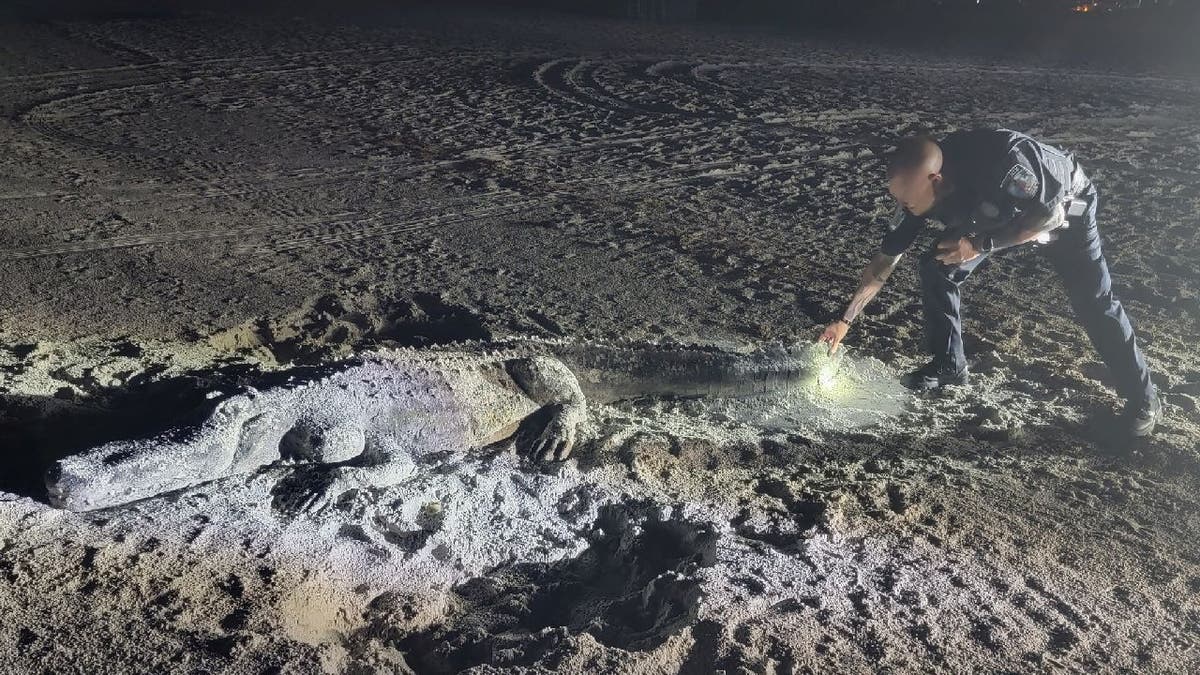Fox News Flash top headlines for May 16
Fox News Flash top headlines are here. Check out what's clicking on Foxnews.com.
A police force on the west coast of Florida was caught by surprise after investigating what appeared to be a large 'alligator' lounging on a sandy beach.
Officers with the Treasure Island Police Department, who stumbled upon the scaly and strangely-still reptile, had realized it was actually a detailed sand sculpture.
The incident happened on Thursday evening and the police department shared a snapshot of the gator sand sculpture to Twitter and Facebook on Friday, May 12.
HUGE ALLIGATOR SWIMMING IN ALABAMA OCEAN SHOCKS BEACH-GOERS: 'NEVER CHARGED OR HISSED'
One of the officers was photographed shining a flashlight on the gator sculpture’s tail while he grabbed the fixed sand.

On May 11, 2023, officers with the Treasure Island Police Department responded to a call about an alligator on the beach. They eventually found out the still alligator was really a sand sculpture. (Treasure Island Police Department)
"Crikey! Look at the size of that gator one of our officers tried rounding up on Treasure Island Beach last night!" The Treasure Island Police Department playfully wrote in its social media posts.
"Ok, it wasn’t a real gator, it was just a crafty crafted sand sculpture," the posts continued.
ALLIGATOR SPOTTED ON TEXAS BEACH BY SEA TURTLE PATROLLERS: 'CAUGHT BY SURPRISE'
The police department followed up its post by informing residents that they should squash sand sculptures before they leave the beach.
"We love the talented people creating works of art in the sand, but with it being turtle nesting season, remember to flatten sandcastles/sculptures before you leave," the department wrote. "The sea turtles will thank you!"
In some cities, failing to flatten a sandcastle or sand sculpture could be a finable or jailable offense.
An Oklahoma couple was fined $1,087 and were given a court date for leaving multiple sand sculptures up overnight during their vacation to Hilton Head Island, South Carolina, in April 2021, according to The Island Packet, a local newspaper.
AMERICA'S STRANGEST ALLIGATOR ENCOUNTERS: SEE THESE 13 STARTLING STORIES
Leaving the sculptures up past sunset reportedly violated local ordinances that prohibit obstructions for the sake of beach-goer and sea turtle safety.

Sea turtles dig holes in sand to create nests where they can lay eggs. Hatched turtles crawl to the sea, but obstructions and lights can make their travel attempt a dangerous one. (iStock)
Nesting sea turtles require flat surfaces to lay eggs and clear paths make it easier for hatched turtles to find the sea after they’ve entered the world.
In 2017, an Alabama youth minister was fined $25 for using a metal tool to dig a one-foot-deep hole near his sandcastle during a spring break trip to Panama City Beach, Florida, according to a report published by Fox 4 Now, a Southwest Florida news affiliate.
CLICK HERE TO SIGN UP FOR OUR LIFESTYLE NEWSLETTER
The Panama City Beach police chief issued a statement at the time saying the city’s sand-digging restrictive ordinance was put in place to protect beachgoers after a rowdy spring break crowd hit the area in 2015, and the $25 fine was issued after the minister repeatedly declined to fill in the hole.

Digging holes in sand is a popular beach activity, but some cities have limits on how deep holes can go. (iStock)
Panama City Beach still prohibits metal shovels and has a two feet depth limit on holes dug in public sand, according to a reminder on local beach ordinances and rules.
FOLLOW US ON FACEBOOK FOR MORE FOX LIFESTYLE NEWS
Fine adverse beach visitors and vacationers should check local laws to see if the destination they’re visiting has restrictions or rules about sandcastles, sand sculptures and sand holes.


